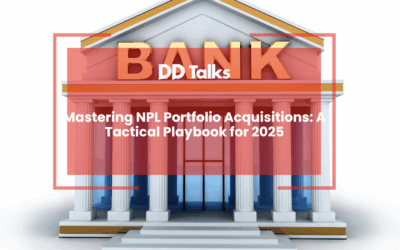Key Takeaways
- Regulatory pressure from the ECB is driving European banks to reduce NPL ratios below 5%, transforming portfolio sales from occasional exercises into strategic imperatives.
- Comprehensive preparation including data enhancement and documentation completion can improve NPL portfolio sale prices by 5-15%.
- Portfolio segmentation into homogeneous pools (secured vs. unsecured, residential vs. commercial) attracts specialist investors and optimizes pricing.
- Performance-based fee structures for advisors typically drive better outcomes than flat-fee arrangements when properly designed.
- Well-organized data rooms with standardized information formats significantly enhance investor confidence and bidding competitiveness.
- Multi-stage bidding processes maintain competitive tension while progressively narrowing the field to serious contenders.
- Post-sale considerations including servicing transitions, regulatory reporting, and ongoing obligations require dedicated teams to manage effectively.
Table of Contents
- Understanding NPL Portfolio Sales: Market Dynamics and Trends
- Key Factors Driving Successful NPL Loan Sale Strategies
- How Can Banks Maximize Returns on NPL Portfolio Sales?
- Selecting and Working with NPL Sale Advisors: Best Practices
- NPL Data Room Preparation: Creating Transparency for Buyers
- Effective NPL Portfolio Marketing and Buyer Sourcing Techniques
- Structuring NPL Deal Negotiations for Optimal Outcomes
- Post-Sale Considerations: Documentation, Accounting and Transition
Understanding NPL Portfolio Sales: Market Dynamics and Trends
The European non-performing loan (NPL) market has evolved significantly over the past decade, shaped by regulatory pressures, economic cycles, and institutional strategies. Currently, we’re witnessing a resurgence in NPL transaction volumes across multiple jurisdictions, with particular activity in Southern Europe, Ireland, and emerging Eastern European markets.
Banks face increasing pressure from the European Central Bank and national regulators to reduce NPL ratios, with many institutions targeting ratios below 5%. This regulatory landscape has transformed what was once an occasional balance sheet management exercise into a strategic imperative for many European banks.
Market trends indicate a growing sophistication among buyers, with specialised investors developing sector-specific expertise in areas such as commercial real estate, corporate loans, and retail portfolios. Pricing dynamics have also evolved, with increased competition narrowing bid-ask spreads in established markets while creating opportunities in emerging NPL jurisdictions where investor presence remains limited.
The NPL markets in the UK and Ireland demonstrate how mature markets can maintain transaction activity even as overall NPL ratios decline, with secondary trading and portfolio optimisation driving continued deal flow. Understanding these market dynamics is essential for banks and servicers planning strategic NPL disposals in today’s competitive landscape.
Key Factors Driving Successful NPL Loan Sale Strategies
Developing an effective NPL loan sale strategy requires careful consideration of multiple interconnected factors. First and foremost, timing plays a crucial role—banks must balance regulatory pressure against market conditions to optimise execution. Selling into a saturated market can significantly impact pricing, while being an early mover in emerging NPL jurisdictions may attract premium bids from investors seeking to establish market positions.
Portfolio composition represents another critical factor. Successful sellers strategically segment their NPL holdings, creating homogeneous pools that appeal to specialist investors. For instance, separating secured from unsecured exposures, or residential from commercial real estate collateral, allows for targeted marketing to investors with specific appetites and expertise.
Data quality fundamentally impacts achievable pricing. Banks that invest in comprehensive data remediation before sale typically achieve higher proceeds, as investors apply smaller risk discounts when loan information is complete and accurate. This includes ensuring property valuations are current, enforcement documentation is readily available, and borrower information is comprehensive.
Regulatory considerations also shape successful strategies. Understanding the capital relief implications of different sale structures, the impact on provisioning levels, and compliance with consumer protection requirements all influence optimal approach selection. Banks that proactively address these factors position themselves for more successful NPL transactions with fewer execution challenges.
How Can Banks Maximize Returns on NPL Portfolio Sales?
Maximising returns on NPL portfolio sales requires a strategic approach that begins well before the formal sales process. The foundation of value optimisation lies in comprehensive preparation. Banks that invest in data enhancement, documentation completion, and collateral valuation updates typically achieve price improvements of 5-15% compared to unprepared portfolios.
Creating competitive tension represents another crucial value driver. Experienced sellers develop targeted investor lists that include both established players and emerging buyers seeking to build market presence. This approach ensures maximum price discovery through multiple bidding rounds, preventing any single investor from dictating terms.
Structuring flexibility also enhances returns. Banks willing to consider alternative transaction structures—such as joint ventures, servicing arrangements, or phased disposals—often achieve better economics than those insisting on clean breaks. These arrangements can bridge valuation gaps by allowing banks to participate in future upside while still achieving immediate regulatory capital benefits.
Servicing optimisation prior to sale delivers significant value. Demonstrating improving collection performance, implementing effective workout strategies, and establishing clear borrower communication protocols reassures investors about portfolio quality. This operational enhancement reduces the risk discount buyers typically apply when calculating their bids.
Finally, transaction timing relative to economic cycles dramatically impacts returns. Banks that can align disposals with positive economic indicators—rising property values, improving employment rates, or increasing investor liquidity—typically achieve stronger pricing than those forced to sell during downturns or periods of market uncertainty.
Selecting and Working with NPL Sale Advisors: Best Practices
Selecting the right advisors for NPL transactions significantly impacts execution quality and ultimate returns. The advisor ecosystem typically includes financial advisors, legal counsel, tax specialists, and sometimes servicing consultants. When evaluating financial advisors, banks should prioritise those with demonstrable transaction experience in relevant asset classes and jurisdictions, as market knowledge and investor relationships directly influence execution success.
Effective engagement models balance advisor incentives with bank objectives. Performance-based fee structures that link compensation to achieved sale prices tend to drive better outcomes than flat-fee arrangements. However, these structures require careful design to prevent advisors from prioritising speed over value maximisation.
Legal advisors with specific NPL transaction expertise provide critical support in structuring sales to address regulatory requirements, consumer protection laws, and data protection regulations. Their early involvement helps identify and mitigate potential execution obstacles before they impact timelines or pricing.
Clear governance frameworks for advisor management streamline decision-making and maintain momentum. Successful banks establish dedicated transaction committees with appropriate delegated authorities, preventing process delays while ensuring proper oversight. These committees typically include representatives from risk, finance, legal, and business units to ensure comprehensive perspective.
Regular performance assessment throughout the engagement helps maintain advisor accountability. Establishing key performance indicators—such as investor engagement levels, data request responsiveness, and adherence to project timelines—provides objective measures for evaluating advisor effectiveness and addressing any performance gaps before they impact transaction outcomes.
NPL Data Room Preparation: Creating Transparency for Buyers
Effective data room preparation represents one of the most influential factors in successful NPL transactions. The data room serves as the primary information repository for potential investors, directly impacting their ability to accurately value the portfolio and formulate competitive bids. Comprehensive data rooms typically include loan-level information, collateral documentation, servicing histories, and legal status updates for each exposure.
Structuring data rooms for intuitive navigation significantly enhances investor experience. Best practices include creating logical folder hierarchies that mirror typical due diligence workflows, implementing consistent file naming conventions, and providing detailed indices that allow investors to quickly locate specific information. This organisation reduces investor frustration and minimises time-consuming information requests.
Data standardisation across the portfolio improves investor confidence. Presenting information in consistent formats—particularly for critical elements like collateral valuations, payment histories, and enforcement status—allows investors to efficiently analyse the entire portfolio rather than struggling with disparate data presentations. Many successful sellers develop standardised templates for key information categories.
Anticipating investor questions through comprehensive data inclusion reduces transaction friction. Experienced sellers proactively include information on historical collection performance, modification attempts, borrower correspondence, and enforcement actions—elements that investors invariably request during due diligence. This proactive approach accelerates the sales process and builds credibility with potential buyers.
Balancing transparency with data protection compliance requires careful planning. Effective data rooms implement appropriate anonymisation techniques for personal information while still providing sufficient detail for accurate valuation. This typically involves redacting direct identifiers while maintaining critical loan characteristics that influence investor pricing models.
Effective NPL Portfolio Marketing and Buyer Sourcing Techniques
Strategic marketing of NPL portfolios requires a sophisticated approach that extends beyond simply announcing a sale. Successful sellers develop comprehensive marketing materials that highlight portfolio strengths while transparently addressing challenges. These materials typically include executive summaries, detailed portfolio stratifications, performance trends, and recovery projections that help investors quickly assess opportunity alignment with their investment criteria.
Buyer sourcing has evolved significantly as the European NPL market has matured. While established investors remain important, experienced sellers now cast wider nets to include emerging players, regional specialists, and asset-specific investors. This expanded approach increases competitive tension and often identifies buyers willing to pay premiums for portfolios that precisely match their acquisition strategies.
Phased marketing approaches typically yield superior results compared to undifferentiated processes. Leading practitioners implement structured sequences beginning with teaser distribution, followed by information memoranda for qualified parties, and culminating in data room access for serious bidders who have demonstrated both interest and capability. This funnel approach maintains momentum while protecting sensitive information.
Investor education represents a critical but often overlooked marketing component, particularly for complex portfolios or emerging jurisdictions. Proactive sellers develop materials explaining local enforcement frameworks, servicing capabilities, and regulatory environments—information that helps investors become comfortable with unfamiliar elements and reduces the risk discounts they might otherwise apply.
Digital marketing channels have gained importance in NPL transactions, with secure online platforms facilitating broader investor reach while maintaining confidentiality. These platforms allow for controlled information dissemination, structured Q&A processes, and efficient bid management, enhancing both process efficiency and competitive dynamics.
Structuring NPL Deal Negotiations for Optimal Outcomes
Effective negotiation structures balance competitive tension with process efficiency. Leading practitioners typically implement multi-stage bidding processes that begin with non-binding indicative offers, progress to binding bids with limited conditions, and culminate in final negotiations with preferred bidders. This phased approach maintains competitive pressure while progressively narrowing the field to serious contenders.
Establishing clear evaluation criteria before receiving bids ensures objective assessment and defensible selection decisions. While price naturally dominates consideration, experienced sellers also evaluate execution certainty, timeline commitments, regulatory approval requirements, and post-closing obligations when selecting preferred bidders. This comprehensive evaluation prevents situations where apparently higher bids ultimately deliver lower realised value due to execution challenges.
Managing information asymmetry represents a critical negotiation challenge. Sellers possess detailed portfolio knowledge that buyers seek to obtain through due diligence and negotiation. Strategic sellers carefully sequence information disclosure to maintain negotiating leverage while building sufficient investor confidence to support aggressive pricing. This typically involves providing core information broadly while reserving detailed insights for advanced negotiation stages.
Negotiation tactics should adapt to specific portfolio characteristics and market conditions. For highly desirable portfolios in competitive markets, auction-style processes that emphasise price competition often yield optimal results. Conversely, for complex portfolios or challenging jurisdictions, collaborative negotiations focusing on structure optimisation may deliver superior outcomes by addressing investor concerns that would otherwise translate into price discounts.
Maintaining credible alternatives throughout negotiations significantly enhances seller leverage. Experienced practitioners develop backup options—whether alternative buyers, portfolio retention strategies, or restructuring approaches—that provide genuine alternatives if primary negotiations falter. This approach prevents situations where sellers become captive to a single buyer’s demands late in the process.
Post-Sale Considerations: Documentation, Accounting and Transition
Comprehensive sale documentation forms the foundation of successful NPL transactions. Beyond standard purchase agreements, effective documentation addresses servicing transitions, ongoing reporting requirements, data protection obligations, and regulatory compliance responsibilities. Experienced sellers develop detailed schedules covering loan-specific information, representations and warranties, and excluded assets to prevent post-closing disputes.
Accounting treatment requires careful planning to achieve desired financial outcomes. Banks must consider how sales impact provisioning levels, regulatory capital calculations, and financial statement presentation. Transactions structured as true sales typically provide cleaner accounting treatment than risk-sharing arrangements, though the latter may offer superior economics in certain scenarios. Early involvement of accounting teams and external auditors helps prevent unexpected financial statement impacts.
Servicing transitions represent one of the most operationally complex aspects of NPL sales. Successful transitions require detailed planning covering borrower notification, document transfer, system migration, and staff communication. Leading practitioners develop comprehensive transition services agreements that clearly delineate responsibilities, establish service levels, and create escalation procedures for addressing inevitable challenges.
Regulatory reporting obligations continue after sale completion. Sellers typically retain responsibilities for historical regulatory filings while assuming new obligations related to the transaction itself. Establishing clear protocols for ongoing regulatory engagement—particularly regarding consumer protection matters—prevents compliance gaps that could trigger regulatory intervention or reputational damage.
Post-closing obligations often extend beyond the immediate transition period. Many transactions include tail provisions covering representations and warranties, indemnification obligations, and information sharing requirements that persist for months or years after closing. Establishing dedicated post-closing teams to manage these ongoing responsibilities ensures continued compliance and protects the economic value achieved through the transaction.
Frequently Asked Questions
What is an NPL portfolio sale?
An NPL (non-performing loan) portfolio sale is a transaction where financial institutions sell packages of loans that are in default or near default to specialized investors. These sales help banks reduce their NPL ratios, improve regulatory compliance, free up capital, and focus on core banking activities while transferring the recovery process to investors with expertise in managing distressed assets.
How do banks determine the right time to sell NPL portfolios?
Banks determine the optimal timing for NPL sales by evaluating multiple factors: regulatory pressure to reduce NPL ratios, current market liquidity and investor appetite, economic cycle positioning, internal resource capacity, and portfolio performance trends. The ideal timing balances regulatory compliance needs against market conditions to maximize returns while avoiding saturated markets where multiple sellers compete for the same investors.
What makes an NPL portfolio attractive to investors?
Attractive NPL portfolios typically feature comprehensive and accurate data, quality collateral with clear legal status, homogeneous loan characteristics (either by asset class or geography), transparent enforcement procedures, and realistic recovery timelines. Investors also value portfolios with established servicing infrastructure, clear borrower communication history, and minimal regulatory or legal complications that could impede the recovery process.
How can banks improve NPL portfolio pricing?
Banks can improve NPL portfolio pricing by investing in data remediation and completion, updating collateral valuations, resolving documentation gaps, demonstrating improving collection performance, creating competitive tension among diverse investors, considering flexible transaction structures (like joint ventures), timing sales during favorable economic conditions, and engaging experienced advisors with strong investor relationships.
What information should be included in an NPL data room?
A comprehensive NPL data room should include loan-level information (original terms, current balance, payment history), collateral documentation (property details, valuations, security agreements), legal status updates (enforcement actions, litigation history), borrower information (appropriately anonymized), servicing records (modification attempts, communication logs), recovery strategies, and performance analytics that help investors understand portfolio characteristics and recovery potential.
What are the key challenges in NPL portfolio transitions?
Key challenges in NPL portfolio transitions include maintaining borrower communication continuity, transferring complete documentation, migrating data between incompatible systems, managing regulatory compliance during handover, addressing staff concerns and knowledge transfer, maintaining collection momentum during transition, and resolving data protection issues when sharing borrower information. Successful transitions require detailed planning, clear responsibility allocation, and comprehensive transition service agreements.
How has the European NPL market evolved in recent years?
The European NPL market has evolved from crisis-driven transactions to a mature marketplace with specialized investors, narrowing bid-ask spreads, and increasing regulatory standardization. Southern European markets (Italy, Greece, Spain) remain active while Eastern European opportunities are emerging. Investor sophistication has increased with sector-specific expertise development, and secondary trading has grown as initial investors optimize their portfolios. Digital platforms and standardized processes have also improved market efficiency and transparency.




0 Comments